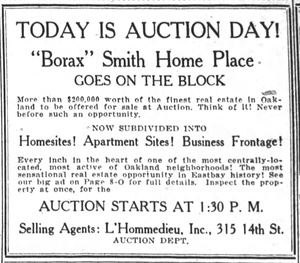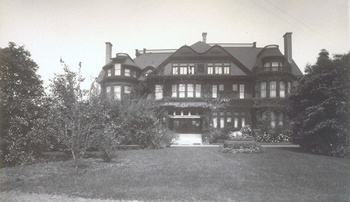 Oak Hall mansion, on Arbor Villa estate of Frank M. Smith 1
Oak Hall mansion, on Arbor Villa estate of Frank M. Smith 1
Arbor Villa (1882-1931) was the name of the large estate owned by Frank M. “Borax” Smith, in Oakland. It included Oak Hall, an extravagant mansion, and 35 acres of grounds with multiple gardens, stables, greenhouses, and more.
Oak Hall Mansion
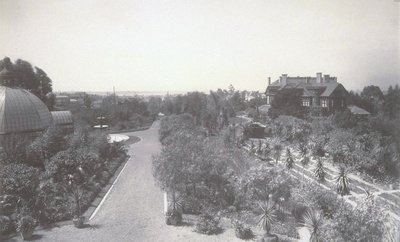 Oak Hall mansion, grounds and greenhouse on the Arbor Villa estate 1
Oak Hall mansion, grounds and greenhouse on the Arbor Villa estate 1 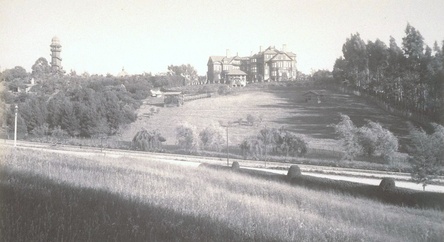 Arbor Villa estate as seen from across Park Boulevard 1
Arbor Villa estate as seen from across Park Boulevard 1
Oak Hall was the name of the mansion on the Arbor Villa estate, a gorgeous, extravagant three story home with at least 42 rooms, including 15 bedrooms; a ballroom; a bowling alley including a ball return; an organ with 18 or more ceiling-height pipes; an attached conservatory; and even a miniature grotto.
Oak Hall was built between 1893–1895 for $275,000 (roughly $7M in 2011 dollars), and was designed by architect Walter J. Mathews,
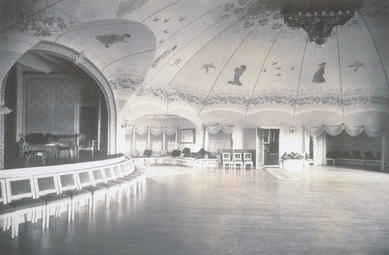 Oak Hall Ballroom 1
Oak Hall Ballroom 1 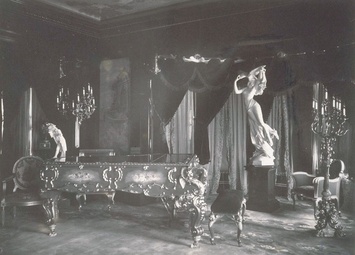 Oak Hall piano 1
Oak Hall piano 1 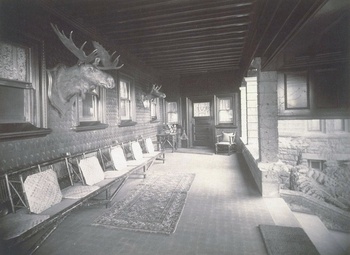 Oak Hall back porch 1
Oak Hall back porch 1 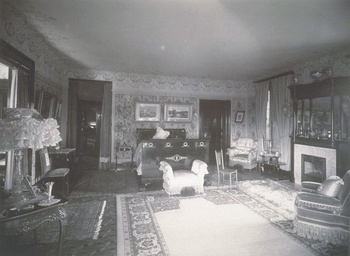 Oak Hall bedroom (one of many) 1
Oak Hall bedroom (one of many) 1 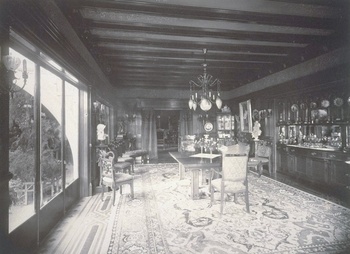 Oak Hall interior 1
Oak Hall interior 1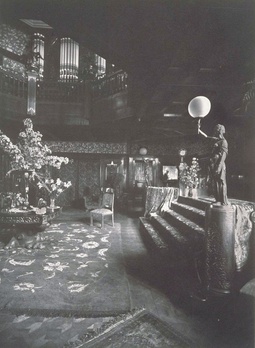 Oak Hall interior 1
Oak Hall interior 1
The Grounds
With so much emphasis on the house, were the grounds an afterthought? Hardly. Squadrons of full-time gardeners had already extensively groomed the 35-acre estate for over a decade before the house was even built. Not for nothing was it called Arbor Villa: there were grape and rose arbors; groves of birch and pine; a large lily pond, a cactus garden … exotic trees and flowers at every turn. The grounds also featured tennis and croquet courts; a paddock with deer and rabbits; a fountain; an archery range; stables; several greenhouses; a 5-story faux water tower with observation deck, and a variety of guest houses and other structures.
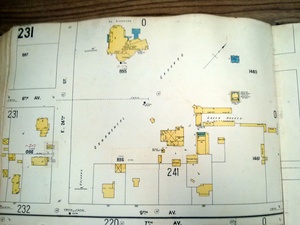 Arbor Villa in Sanborn Maps
Arbor Villa in Sanborn Maps
Courtesy the Oakland History Center of the Oakland Public Library 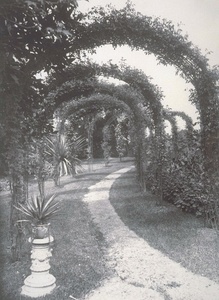 Arbor Villa grounds 1
Arbor Villa grounds 1 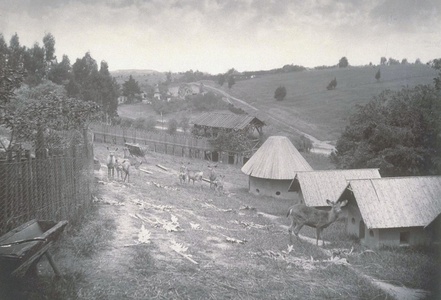 Arbor Villa deer in paddock, with rabbit hutches 1
Arbor Villa deer in paddock, with rabbit hutches 1 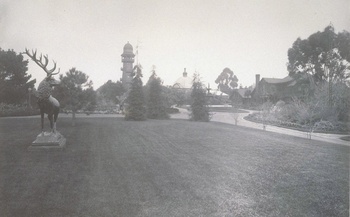 Arbor Villa grounds with stag sculpture on lawn 1
Arbor Villa grounds with stag sculpture on lawn 1  Arbor Villa path to five-story observation tower on grounds 1
Arbor Villa path to five-story observation tower on grounds 1 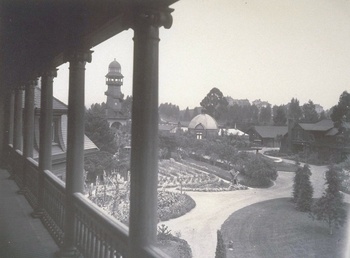 Arbor Villa grounds as seen from Oak Hall balcony 1
Arbor Villa grounds as seen from Oak Hall balcony 1
Part of Oakland Life
From 1895 until the 1920s the Smiths opened Arbor Villa to the public fairly regularly, holding numerous fundraising events and society balls, which generated vast sums for charitable causes (like Oakland Free Kindergarten, or Fabiola Hospital). These events, especially in the early years, were the place to be. A San Francisco Call article (Vol. 105, #153, 2 May 1909) describing one such May Day fundraiser, mentions familiar names from Oakland history: de Fremery, Remillard, Chabot, Capwell, Schilling.
A society column in the San Francisco Call (Vol. 85, #144, 23 April 1899) reads:
The most brilliant affair of the week of course was the reception which Mr. and Mrs. F. M. Smith gave on Wednesday evening at their charming home, Arbor Villa, in East Oakland, to which over 1300 guests from both sides of the bay were bidden.
A Tribune article from the same year was titled “society queens rule at Smith grand ball.”
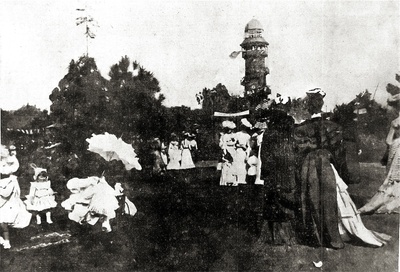 “The day was ideal, and the women and children, in pretty summer gowns, dotted the vast garden like moving flowers …” — S.F. Call (Vol. 93 #154, 3 May 1903)
“The day was ideal, and the women and children, in pretty summer gowns, dotted the vast garden like moving flowers …” — S.F. Call (Vol. 93 #154, 3 May 1903) 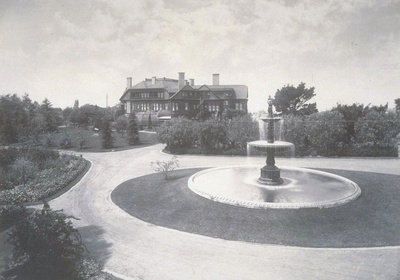 Oak Hall mansion on Arbor Villa estate, with fountain in foreground 1
Oak Hall mansion on Arbor Villa estate, with fountain in foreground 1
The End
Smith made and lost at least two fortunes over the years, so he was used to some turmoil. But in 1928, Smith suffered a series of strokes. Evelyn took control of the business affairs, and they gave up Arbor Villa and moved to Adams Point.
Some of the furnishings of Oak Hall were auctioned off in 1930, 3 and the land was auctioned off starting in 1931. 2 According to Borax Smith historian Phil Bellman, Oak Hall was torn down January 13, 1932.
The villa is gone but you might want to check out those palm trees…
The Dooley 1902 photos (all of the above interior views, and most of the outside ones) are usually what gets jaws dropping and people talking, especially when you visualize all this superimposed on the area as it is today.
Phil Bellman gives walking tours about Borax Smith for the Oakland Heritage Alliance. If you get the chance, the tour is highly recommended.
Questions/Answers:
- Who decided to tear Oak Hall down? — Who else … real estate developers! They even burned down the observation/water tower as a publicity stunt. I imagine I’m not alone in detecting an element of class-based “payback” in the apparent vengeful glee with which this task was conducted, plus the lack of record of any formal opposition to it. (Infuriatingly, these were the same developers who for years had used proximity to Arbor Villa to sell nearby tracts at a premium.)
-
Why was Arbor Villa not turned into a museum with park grounds like the Dunsmuir Hellman House? – (I know, right?) Places like D-H or Hearst Castle were somewhat protected by out-of-the-way locations, whereas Arbor Villa’s being situated strategically so close to Oakland’s heart made it a sitting duck, unable to resist developers’ depredations. After the 1929 crash, no buyer could be found for any house that big (anyone with enough money having long since absconded to Piedmont) plus the city of Oakland was still decades away from any preservational awareness. But if any structure in Oakland ought to have been spared … it was called “Oak Hall” for a reason, you know: no expense had been spared in paneling each room in a different exotic wood (for example, IIRC the downstairs central lobby – overseen by Bernard Maybeck – was done entirely in koa) – and the hallways, done in oak, tied everything together. (And not paper-thin veneers, either – we’re talking ¾-inch slabs of the most select grades available. The building really should’ve been sold to the Gibson guitar company!)
The Ivy Hill area is kinda bouncing back now, but was always the hood when I was growing up. Now, try to imagine if you will, an alternate history – in which the City of Oakland had somehow had the foresight to retain Arbor Villa (if only as a thank-you to someone who’d handed them, oh, I dunno, a private orphanage system … a transportation infrastructure … various large public works … to name a few). Having a big castle on the hill – even if only used occasionally for private functions or city administrative offices – might well have exerted enough influence, over time, to have kept the whole area from ever becoming ‘hood. Food for thought … -
Check out this obit for Borax’s last surviving daughter. It says the house was torn down in 1932, a year after Borax died. I did a bit of searching on NewspaperArchive.com, and couldn’t find an article about the demolition, but I did find ads from the time period for homes in the subdivision known as "Arbor Villa, Borax Smith-Home Place," and a map was apparently filed on 10/15/31. (See the pix below) My guess is that the family started selling off pieces of the property before Borax died. — NAParish
- You guessed right. What’s more (as we’ll no doubt hear in more detail on Saturday), to make ends meet (especially after the events of 1913), the Smiths had been forced to sell off big chunks of Arbor Villa while they still lived there. It’s already such a sad tale, I’ve been omitting details, but in Smith’s biography it’s mentioned how the old man, now mute after a stroke, would twitch at the sound of his beloved trees being felled outside … knowing the vultures are circling can’t be good for anyone’s health! Anyhow, yes, the demolition proceeded in stages. I even know of one c. 1931 photo showing the house still in place … but completely surrounded by apartments and whatever else is there now. It’s too depressing to post, but I think the Oakland Museum has it (mislabeled, with bad metadata).
 Legal description for 740 Beatie St - note reference to 1931 map
Legal description for 740 Beatie St - note reference to 1931 map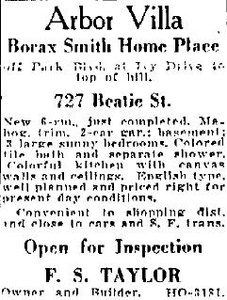 Ad from 5/1/32 Trib
Ad from 5/1/32 Trib
Links and References
- Image(s) used by permission of the UC Berkeley, Bancroft Library
- auction ad Oakland Tribune October 4, 1931
- Treasures of Oak Hall Go Under Hammer Oakland Tribune October 1, 1930


